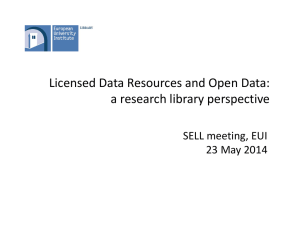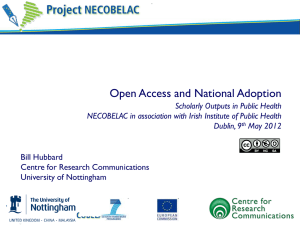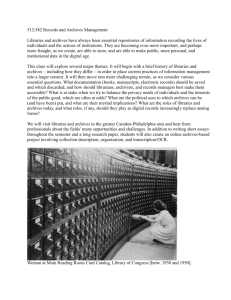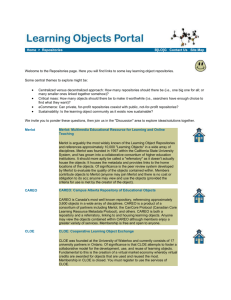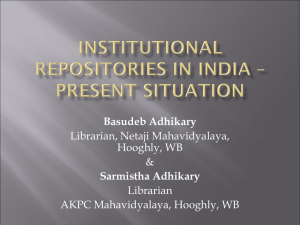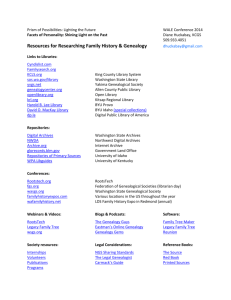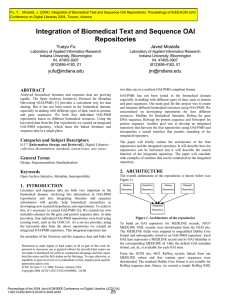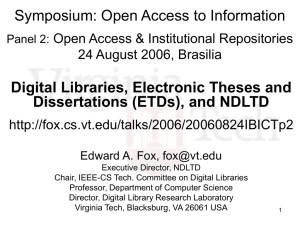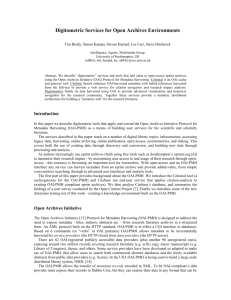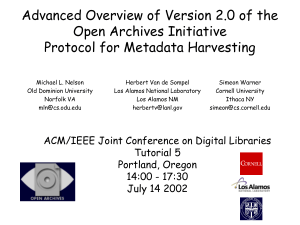View/Download - Boston University
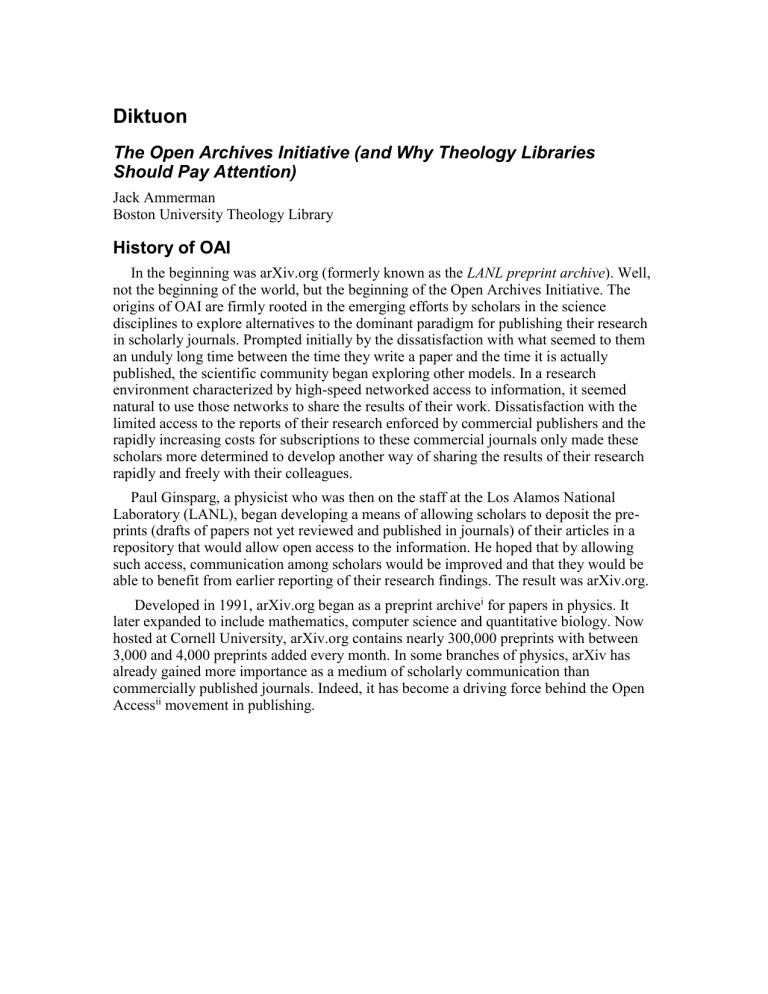
Diktuon
The Open Archives Initiative (and Why Theology Libraries
Should Pay Attention)
Jack Ammerman
Boston University Theology Library
History of OAI
In the beginning was arXiv.org (formerly known as the LANL preprint archive ). Well, not the beginning of the world, but the beginning of the Open Archives Initiative. The origins of OAI are firmly rooted in the emerging efforts by scholars in the science disciplines to explore alternatives to the dominant paradigm for publishing their research in scholarly journals. Prompted initially by the dissatisfaction with what seemed to them an unduly long time between the time they write a paper and the time it is actually published, the scientific community began exploring other models. In a research environment characterized by high-speed networked access to information, it seemed natural to use those networks to share the results of their work. Dissatisfaction with the limited access to the reports of their research enforced by commercial publishers and the rapidly increasing costs for subscriptions to these commercial journals only made these scholars more determined to develop another way of sharing the results of their research rapidly and freely with their colleagues.
Paul Ginsparg, a physicist who was then on the staff at the Los Alamos National
Laboratory (LANL), began developing a means of allowing scholars to deposit the preprints (drafts of papers not yet reviewed and published in journals) of their articles in a repository that would allow open access to the information. He hoped that by allowing such access, communication among scholars would be improved and that they would be able to benefit from earlier reporting of their research findings. The result was arXiv.org.
Developed in 1991, arXiv.org began as a preprint archive i for papers in physics. It later expanded to include mathematics, computer science and quantitative biology. Now hosted at Cornell University, arXiv.org contains nearly 300,000 preprints with between
3,000 and 4,000 preprints added every month. In some branches of physics, arXiv has already gained more importance as a medium of scholarly communication than commercially published journals. Indeed, it has become a driving force behind the Open
Access ii movement in publishing.
When arXiv.org was one of only a small number of other archives, keeping the archives synchronized was not too difficult. The concept became widely accepted in the scientific community, though, and the number of archives quickly grew. By the late
1990s, it became apparent that searching across archives and keeping repositories in sync with each other was becoming a more difficult task. The software, usually developed inhouse (or at least modified) by each institution, did not allow easy communication between the repositories. In 1999, a group of scientists met in Santa Fe to begin developing interoperability standards that would allow the archives to easily communicate with each other. The result was the Open Archives Initiative (earlier known as the Santa Fe Convention) and the beginning of a framework that would facilitate the federation of content providers on the Web.
How OAI Works
The dual foci of the Santa Fe participants on interoperability and low-barrier solutions largely shaped the development of the Open Archives Initiative. The interoperability focus has several facets, including uniform naming, metadata formats, document models, and access protocols. The commitment of the participants to a low-barrier solution was vital to the widespread adoption among E-print providers. Adopting an interoperability solution known as metadata harvesting was a solution that allows E-Print (content) providers to expose their metadata via an open interface, with the intent that this metadata be used as the basis for value-added service development.
Unlike federated searching that allows the end-user to simultaneously search multiple databases or digital repositories and to display the result sets merged in some fashion, the
Open Archives Initiative Protocol for Metadata Harvesting (OAI-PMH) is not designed as an end-user search tool. Instead, a service provider uses a Harvester to gather metadata from Repositories
. A “harvester” is client software that issues OAI-PMH requests. A “repository” is a network accessible server that can respond to OAI-PMH requests. Generally the service provider runs the harvester at off-peak times and stores the harvested metadata in a database that can be searched by the end-user. This model is similar in some ways to those used by major Internet search engines like Yahoo and
Google. Internet search engines send out “spiders” or “bots” that locate and retrieve pages from Web servers for indexing. The end-user doesn't search the Internet directly, bu searches the database created by the Internet search engine. The OAI repositories are different in several significant ways, however.
The OAI-PMH specifies that repositories must be able to return records with metadata expressed in Dublin Core format without qualification. A repository may optionally return metadata in additional formats. Additional formats might be used to provide a richer set of metadata appropriate to a particular collection of digital objects. The common metadata format is essential to interoperability, however. One might argue that
Dublin Core without qualification doesn't provide the richness of a record in MARC21 or the Religion Database records. Anyone who has attempted to search the ATLA Religion
Database simultaneously with other databases, however, knows the enormous problems created when databases don't share a common metadata format. When you do search
ATLA Religion Database along with another database on EBSCOhost, for example, the
Scripture index is not available. The searcher is limited to searching fields common in all the databases.
Another significant difference is that the repositories searched are known repositories of items that are generally recognized to have significance to scholars. The harvester doesn't attempt to browse the entire Web. Its efforts are focused on what some have called the “Deep Web.” One still must use care in using resources located in repositories.
Pre-prints, for example, have yet to go through a peer-review process and may provide invalid information. Overall, however, the quality of resources held in such repositories is quite high.
A repository can organize its digital objects into sets or collections that make sense.
For example, a repository might have a collection of images, or a collection of sermons.
Some repositories house electronic theses and dissertations. Items might also be organized by subject. The developer's desire to organize the digital objects in the repository is not constrained by the OAI-PMH.
I won't attempt to describe in detail the protocol other than to say that it specifies six verbs that are used by the harvester to request information from the repository. The repository can:
Identify itself to the harvester, providing administrative details [Identify]
List the metadata formats available [ListMetadataFormats]
Describe the organization of the digital objects it holds [ListSets]
List the records in the repository or set [ListRecords]
List the records providing only the header information [ListIdentifiers]
Retrieve a specific record including a URL or pointer to provide access to the searcher [GetRecord]
These verbs are sent as HTTP requests in the format http:// <base_url>?verb=<verb> .A request to the Library of Congress American Memory project OAI server, for example, might look like: http://memory.loc.gov/cgi-bin/oai2_0?verb=Identify
With modifiers or parameters included with the HTTP request, the harvester can achieve some measure of granularity, requesting only records from a specified set created after a specified date, for example. All responses from the repository are sent to the harvester in
XML. The harvester parses the response, stores it in a database. A detailed description of the OAI-PMH can be found at: http://www.openarchives.org/ . A full description of
Dublin Core can be found at: http://dublincore.org/ .
Library Uses of OAI
The original focus of the Open Archives Initiative on scientific E-prints quickly expanded to include content providers from a wide variety of disciplines. Librarians soon became interested in its applicability to many of the digital collections being developed through their own scanning efforts. Key members of the research library community met at the so-called Cambridge Meetings , hosted at Harvard and sponsored by the Digital
Library Federation and the Andrew W. Mellon Foundation. The goal of the meetings was to explore ways that major research libraries might expose aspects of their collections to
Web search engines. The Cambridge Meetings participants, who included representatives from both research libraries and from the museum community, agreed that exposing metadata in a common format was a key step toward accomplishing their goal.
As the community of interest broadened, the technical specifications designed specifically for E-prints were revised to be capable of addressing the requirements of a broader range of digital options. In addition, the Digital Library Federation (DLF) and the
Coalition of Networked Information (CNI) announced organizational support for the OAI as a means of providing more stability and credibility to the effort to establish interoperability standards.
So why should theology libraries pay attention to the OAI?
While the protocol is still developing and in some ways might be considered experimental, it clearly has the support of a large portion of the library community behind it. Software to manage repositories of digital objects, for example, is being developed to expose metadata in an OAI-PMH compliant format. The dSpace ( http://dspace.org
) project at the Massachusetts Institute of Technology, and the Fedora Project
( http://www.fedora.info
) being developed at the University of Virginia are examples of open source efforts repositories being developed. Many commercial vendors have also begun developing the ability to respond to OAI-PMH requests from harvesters. A number of repositories are already able to respond to harvesters. In addition to the many E-prints repositories that might hold documents of particular interest to those studying science and religion, repositories for electronic theses and dissertations are being developed. Major funded digitization projects like the “Making of America Project” and the “Documenting the American South” hold much material of interest to scholars and students of theology and religion.
Search engines (harvesters) are available. One of the most comprehensive is OAIster
( http://www.oaister.org
). OIAster's self-description is:
OAIster is a project of the University of Michigan Digital Library Production
Service. Our goal is to create a collection of freely available, previously difficultto-access, academically-oriented digital resources that are easily searchable by anyone.
A recent search on the phrase “methodist episcopal church” retrieved 13,720 records.
Adding the term “sermons” as a second term reduced the number of records to 24.
A number of tools are available for the less technologically challenged who want to try building their own harvesters. However, there are harvesters available at no cost that require far less expertise to setup and run. One has been developed by the Public
Knowledge Project at the University of British Columbia. For this article, I downloaded and installed the software. It took about fifteen minutes to install and configure, though having background in OAI and Web server administration helped. It can be searched at http://comm745-server.bu.edu/harvester/ . It is available for readers to explore. I've done very little to customize it beyond adding the Library's name to the banner. (It should not be considered in production mode.) I harvested records from several repositories including the University of North Carolina, the University of Michigan, E-Lis (a repository of documents about Library and Information Science), and Project Perseus.
The Open Archives Initiative is a significant development in the effort to develop standards for interoperability among digital repositories. Theology libraries will surely find it benefiting their users and prompting us to expose our digital collections to broader access. i Note: the use of the term archive in the scientific community is generally recognized to refer to a repository of scholarly papers and thus differs from more traditional understandings of the term among professional archivists and librarians. ii See The SPARC Open Access Newsletter ( http://www.earlham.edu/~peters/fos/ ) and
Open Access News ( http://www.earlham.edu/~peters/fos/fosblog.html
) for additional information in the Open Access movement.

